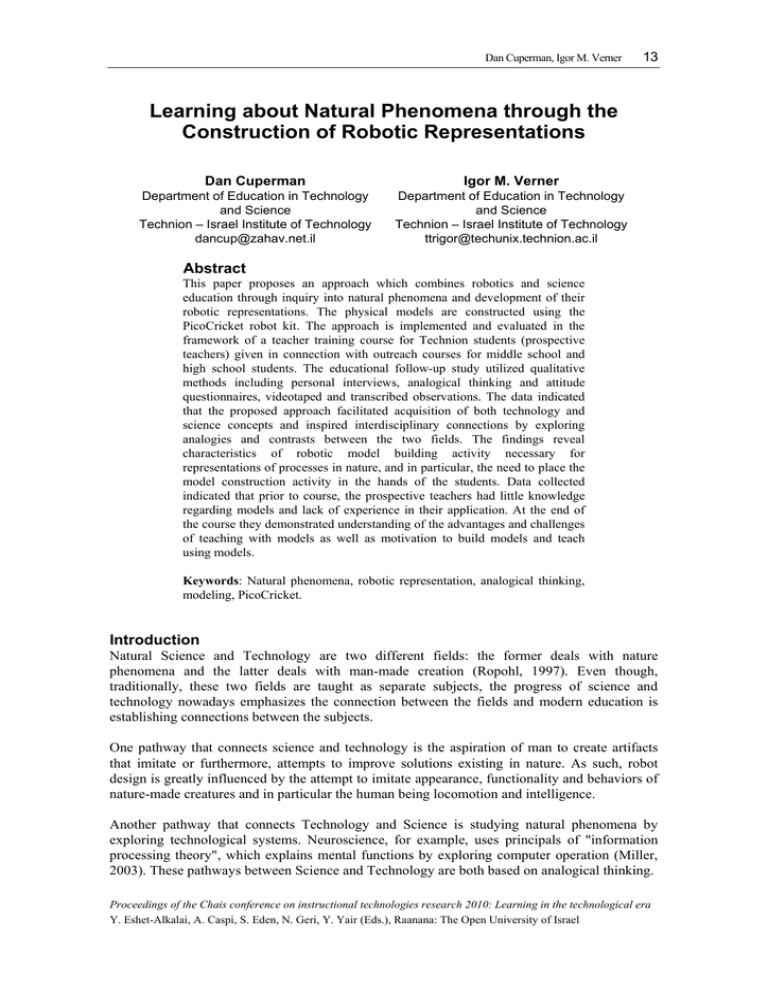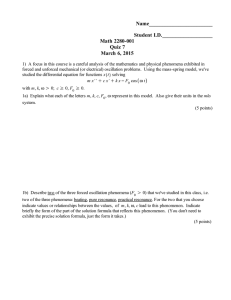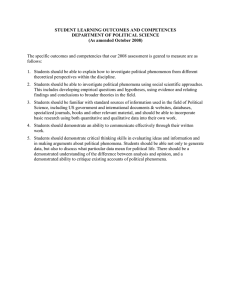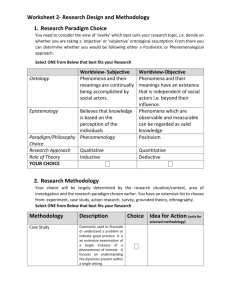Learning about Natural Phenomena through the Construction of
advertisement

Dan Cuperman, Igor M. Verner 13 Learning about Natural Phenomena through the Construction of Robotic Representations Dan Cuperman Igor M. Verner Department of Education in Technology and Science Technion – Israel Institute of Technology dancup@zahav.net.il Department of Education in Technology and Science Technion – Israel Institute of Technology ttrigor@techunix.technion.ac.il Abstract This paper proposes an approach which combines robotics and science education through inquiry into natural phenomena and development of their robotic representations. The physical models are constructed using the PicoCricket robot kit. The approach is implemented and evaluated in the framework of a teacher training course for Technion students (prospective teachers) given in connection with outreach courses for middle school and high school students. The educational follow-up study utilized qualitative methods including personal interviews, analogical thinking and attitude questionnaires, videotaped and transcribed observations. The data indicated that the proposed approach facilitated acquisition of both technology and science concepts and inspired interdisciplinary connections by exploring analogies and contrasts between the two fields. The findings reveal characteristics of robotic model building activity necessary for representations of processes in nature, and in particular, the need to place the model construction activity in the hands of the students. Data collected indicated that prior to course, the prospective teachers had little knowledge regarding models and lack of experience in their application. At the end of the course they demonstrated understanding of the advantages and challenges of teaching with models as well as motivation to build models and teach using models. Keywords: Natural phenomena, robotic representation, analogical thinking, modeling, PicoCricket. Introduction Natural Science and Technology are two different fields: the former deals with nature phenomena and the latter deals with man-made creation (Ropohl, 1997). Even though, traditionally, these two fields are taught as separate subjects, the progress of science and technology nowadays emphasizes the connection between the fields and modern education is establishing connections between the subjects. One pathway that connects science and technology is the aspiration of man to create artifacts that imitate or furthermore, attempts to improve solutions existing in nature. As such, robot design is greatly influenced by the attempt to imitate appearance, functionality and behaviors of nature-made creatures and in particular the human being locomotion and intelligence. Another pathway that connects Technology and Science is studying natural phenomena by exploring technological systems. Neuroscience, for example, uses principals of "information processing theory", which explains mental functions by exploring computer operation (Miller, 2003). These pathways between Science and Technology are both based on analogical thinking. Proceedings of the Chais conference on instructional technologies research 2010: Learning in the technological era Y. Eshet-Alkalai, A. Caspi, S. Eden, N. Geri, Y. Yair (Eds.), Raanana: The Open University of Israel 14 Learning about Natural Phenomena through the Construction of Robotic Representations Gentner & Colhoun (in press) notes that analogy can promote learning of an unknown domain by comparing or inferring from internal relations of a known domain. Ming (2009) highlights that when comparing the two domains, the learner can benefit of analogies and contrasts. According to the definition of analogy (Hestenes, 2006), it is defined as mapping of structure and attributes from one domain (source) to another (target) which specifies differences as well as similarities between the domains. Learning by analogy and contrast is the focus of modeling activities, where the model is a simplification of a complex system or phenomenon used to aid the formation of knowledge representations (Gilbert, 2005). Halloun (2004) points out that in science education, modeling natural phenomena is an iterative process, in which any single iteration is a cycle consisted of two main stages: model development and model deployment. One can see that these two stages follow the two abovementioned pathways: model development is based on imitation of the phenomenon, while model deployment extends knowledge about the phenomenon. Bio-inspired robotics is grounded on the development of robotic models that imitate biological processes. Erlhagen et al (2006) suggests a broader meaning of the imitation, including robot learning as replication of a human learning behavior. Rusk et al. (2008) state that robotics activities can offer rich educational opportunities, but are typically introduced in a narrow way, as building mobile robots. The authors propose strategies for introducing students to robotics technologies and concepts. They suggest and demonstrate implementing these strategies using innovative construction kits. The study presented in this paper develops an integrative approach to science and technology education which combines the new strategies of robotics education (Rusk et al. 2008) that emphasize the connection between science and technology. The proposed approach is based on constructing robot systems, as imitational models of natural phenomena, and inquiry into analogies and contrasts between them. The Construction Kit For constructing the models we used the PicoCricket robotics kit which has been designed "for making artistic creations with lights, sound, music, and motion" (http://www.picocricket.com). The PicoCricket is a tiny programmable computer that can operate light, sound, and motion actuators, collect data and react on input from a variety of sensors, and provide bi-directional infrared communication with the host computer and other PicoCricket. The PicoBlocks software for programming the PicoCricket is intuitive and uses graphical blocks which are simply snapped together to create a program (similar to LEGO bricks). Modeling Natural Phenomena with PicoCricket In this section we will present two examples of instructional models that were developed in the framework of teacher training courses and outreach courses for high school students at the Department of Education in Technology and Science, Technion. The examples represent a series of models developed for demonstrating various types of tropism in plants and various homeostasis functions in biological organisms. Dan Cuperman, Igor M. Verner 15 Heliotropism: A Sunflower Functional Model Inquiry into the phenomenon The daily solar-tracking movement of plants is called heliotropism (Sherry & Galen, 1998), and is demonstrated most impressively in the sunflower plant ("Helianthus annuus"). The flowerhead movement is initiated by phototropins (light-sensitive proteins) triggering differential translocation of auxin (a plant growth hormone) causing greater cell elongation in the shaded side of the stem, bending the stem and ending in the flower-head pacing the sunny side (Sherry & Galen, 1998). Building the Model The sunflower model, shown in Figure 1, includes two light sensors, a dc motor, driving mechanism, a "flower-head" structure, and some additional Lego blocks. The model functioning is controlled by the PicoCricket which executes the program written by PicoBlocks software. The heliotropism phenomenon is imitated by continuously comparing the amount of light measured by the sensors, and turning the "flower-head" structure towards the direction indicated by the higher reading sensor. Figure 1. The sunflower model: A. Light sensors; B. Flower-head; C. PicoCricket; D. dc motor Homeostasis of the Eye: An Iris Functional Model Inquiry into the Phenomenon The eye has the ability to regulate the light intensity penetrating through the pupil, and reaching the retina. The process is controlled by the brain. The pupil size is determined by the iris, made up of circularly arranged muscles. When light increase, the muscles shrinks the pupil area, and limits the light flux at the retina (Zeron, 2008). Building the Model The eye model, shown in Figure 2, includes a light sensor, a dc motor, a belt driving mechanism, a lens iris mechanism, a ball shell (not shown) and some Lego blocks. The model functioning is controlled by the PicoCricket. The phenomenon is imitated by continuously regulating the amount of light reaching the sensor trough the lens, by actuating the lens iris via the dc motor. 16 Learning about Natural Phenomena through the Construction of Robotic Representations Figure 2. The mechanism of the eye model: A. Light sensor; B. Iris; C. PicoCricket; D. dc motor. The Educational Study The goal of this study is to develop and examine the learning process which combines the design of technological systems and the inquiry into nature phenomena by means of modeling activities and analogical thinking. The research questions derived from this goal are as follows: 1. What are the principles of designing robotic models to be used for studying processes in nature, and what are the characteristics of the learning environment which utilizes these models in the scientific inquiry? 2. What are pre-service teachers' attitudes towards teaching and learning aided by robotic models, and how are these attitudes affected by the teaching practice? 3. What perceptions of the analogies between the natural phenomenon and the technological models are developed in school students following their participation in the modeling activities? The participants of the study were: - Technion students majoring in science and technology education (N=11), - 10th graders who studied advanced high school biology and participated in our outreach course (N=5), - Middle school students, who were taught by the Technion students in the framework of the teaching practice course (N=10). We implemented the multi-tiered approach (Lesh & Kelly, 2000) to studying symbiotic educational processes, in which different groups of learners share a common learning environment. The educational objectives differ between the three groups (tiers): the Technion students studied modeling and project based education, the high school students were engaged in modeling biological phenomena using technological systems, and the middle school students were introduced to various nature phenomena and their modeling by means of robotic systems. With these different objectives, all the groups learned through hands on practice with the same kits and in the same departmental laboratory of technology. Data on learners' attitudes and perceptions were collected and analyzed using qualitative methods (questionnaires, interviews, and videotaped observations). Findings Findings related to the first research question, reveals the following characteristics of robotic model building activity taking place when making representations of processes in nature: Dan Cuperman, Igor M. Verner 17 1. It is essential for the students themselves to be involved in the model construction activities. This call is supported both by prospective teachers and students, and is in line with data from other researches. 2. A typical process of analogical thinking application is involved in the model development. 3. The learner is building and improving the model in a typical iterative cycle of research, development and evaluation. 4. In practice, there will always be aspects of the source not reflected in the model, as well as attributes of the model not deriving from the source. The students are well aware of this fact and can identify differences as well as similarities between the model and the source. Findings related to the second research question, reveals poor theoretical and practical background knowledge regarding educational models in behalf of prospective teachers. This knowledge was significantly improved during the course, leaving the prospective teachers with a body of knowledge about the advantages and challenges of teaching with models, good attitudes towards teaching and learning aided by robotic models and motivation to build models. Findings related to the third research question derived from the post-course analogy questionnaire. Students were asked to scrutinize in the analogy between the studied natural phenomena and the technological models built to represent them. The questionnaire referred to the five types of model structures characterized by Hestenes (2006): (systemic structure, geometric structure, object structure, interaction structure, temporal structure). The data analysis indicated that at the end of the course the students had knowledge of each studied phenomenon and its robotic model. The questionnaire reflects students' familiarity with the concepts and ability to discuss the phenomena and the models using the right terminology. This can be illustrated by the following citations: "When the sunflower plant receives more sunlight in one side then the other, the protein receiving the light passes information to transfer more auxin to one side then the other…The light sensors receive light, and the side with more light is detected. The motor moves the model to the side in which the sensor detects more light" (middle school student). The questionnaire showed the consistency of students' evaluations of the analogies and contrasts between the phenomenon and the model. In particular all the students agreed that the models were analogous to the natural phenomena with respect to the systemic structure (including composition and internal connections), object structure, and interaction structure. The students pointed to the contrasts between the models and the natural phenomena in the systemic structure (with regard to environment and external connections), geometric structure, and temporal structure. Students overall evaluation of the models was that there is good analogy between the models and the phenomena. This evaluation is explained in the following citation: "The components are analogous and the response is nearly identical in al aspects. It is very similar" (middle school student). 18 Learning about Natural Phenomena through the Construction of Robotic Representations Conclusion Modern education calls for introducing robotics activities in a broad way by focusing on thematic inquiry, creativity and self-expression, verbalization and communication of experiential knowledge. Our approach follows this way and directs towards integrating robotics studies with inquiries into natural science phenomena. It stresses the important role of robotics modeling in promoting the study of analogies and contrasts between the natural and technological systems. In this approach a natural phenomenon serves a motive for developing a robotic model, while experimentation with the robotic model facilitates deeper understanding of the mechanisms underlying the phenomenon. We observed this effect in the two modeling projects presented in the paper as well as in other projects. The study showed that knowledge acquisition occurred due to the course. The technological knowledge was a product of formal and intuitive learning that took place during the course. The information about the natural phenomenon was sought and the knowledge was self acquired by the students throughout building and exploring the robotic model which was the motivator of learning and the object-to-think-with. The case studies demonstrated that the proposed approach indeed inspired students' analogical thinking. The students were productive in unveiling both analogies and contrasts between natural and technological systems. An interesting result is that in spite of finding contrasts between the model and the phenomenon, the students still accepted the model as having a good analogy with the phenomenon. We analyzed the cases of "good analogy" and found that these evaluations related to the three types of model structures, namely, internal systemic structure, object structure and interaction structure. The authors recommend further investigation and implementation of the proposed approach in robotics education. References Erlhagen, W., Mukovskiy, A., Bicho, E. et al. (2006). Goal-directed imitation for robots: A bio-inspired approach to action understanding and skill learning, Robotics and Automation Systems, 54, 353-360. Gentner, D., & Colhoun, J. (In press). Analogical processes in human thinking and learning. In A. von Müller & E. Pöppel (Series Eds.) & B. Glatzeder, V. Goel, & A. von Müller (Vol. Eds.), On Thinking: Vol. 2. Towards a Theory of Thinking. Springer-Verlag Berlin Heidelberg. http://groups.psych.northwestern.edu/gentner/papers/gentnerColhouninPress.pdf Gilbert, J. K. (2005). Visualization in Science Education. Springer, pp. 9-27. Halloun, I. A. (2004). Modeling theory in science education, p. 186. Science & Technology Education Library, Kluwer Academic Publishers, London. Hestenes, D. (2006). Notes for a Modeling Theory of Science, Cognition and Instruction, Proceedings of the 2006 GIREP conference: Modelling in Physics and Physics Education. http://modeling.asu.edu/R&E/Notes_on_Modeling_Theory.pdf Lesh, R., & Kelly, A., (2000) Multitiered Teaching Experiments. In A. Kelly, R. Lesh (Eds.), Research Design in Mathematics and Science Education. (pp. 197-230). Lawrence Erlbaum Associates, Mahwah, New Jersey. Miller, G. A.(2003). The Cognitive Revolution: a Historical Perspective, Trends in Cognitive Sciences, 7(3), 1411-44. Dan Cuperman, Igor M. Verner 19 Ming, N. C. (2009). Analogies vs. Contrasts: a Comparison of their Learning Benefits, Proceedings of the 2nd International Analogy Conference. ANALOGY 09. http://www.nbu.bg/cogs/analogy09/proceedings/36-T44.pdf Ropohl, G. (1997). Knowledge Types in Technology. International Journal of Technology and Design Education, 7, 65-72. Rusk, N., Resnick, M., Berg, R., & Pezalla-Granlund, M. (2008). New pathways into robotics: Strategies for broadening participation. Journal of Science Education and Technology, 17(1), 59–69. Sherry, R. A., & Galen, C. (1998). The mechanism of floral heliotropism in the snow buttercup, Ranunculus adoneus. Plant Cell and Environment, 21, 983-993. Zeron, E. S. (2008). Positive and Negative Feedback in Engineering. Mathematical Modeling of Natural Phenomena, 3(2), 67-84.




